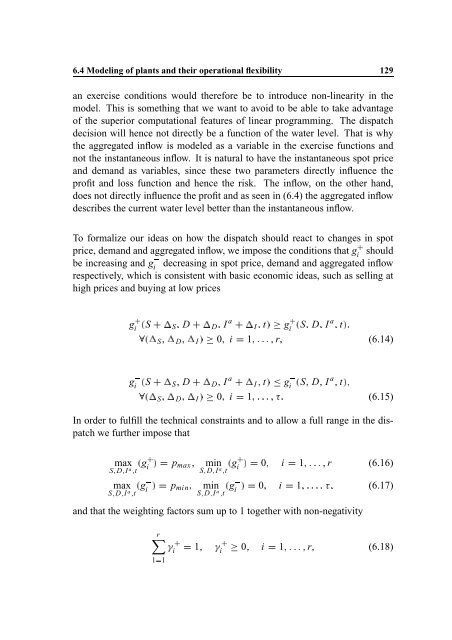Hedging Strategy and Electricity Contract Engineering - IFOR
Hedging Strategy and Electricity Contract Engineering - IFOR
Hedging Strategy and Electricity Contract Engineering - IFOR
Create successful ePaper yourself
Turn your PDF publications into a flip-book with our unique Google optimized e-Paper software.
gìi<br />
Û S í SÜ D í DÜ I a í I Ü tÝ gìi<br />
Û SÜ DÜ I a Ü tÝ?Ü<br />
õ<br />
á<br />
6.4 Modeling of plants <strong>and</strong> their operational flexibility 129<br />
an exercise conditions would therefore be to introduce non-linearity in the<br />
model. This is something that we want to avoid to be able to take advantage<br />
of the superior computational features of linear programming. The dispatch<br />
decision will hence not directly be a function of the water level. That is why<br />
the aggregated inflow is modeled as a variable in the exercise functions <strong>and</strong><br />
not the instantaneous inflow. It is natural to have the instantaneous spot price<br />
<strong>and</strong> dem<strong>and</strong> as variables, since these two parameters directly influence the<br />
profit <strong>and</strong> loss function <strong>and</strong> hence the risk. The inflow, on the other h<strong>and</strong>,<br />
does not directly influence the profit <strong>and</strong> as seen in (6.4) the aggregated inflow<br />
describes the current water level better than the instantaneous inflow.<br />
To formalize our ideas on how the dispatch should react to changes in spot<br />
price, dem<strong>and</strong> <strong>and</strong> aggregated inflow, we impose the conditions that gëi<br />
should<br />
be increasing <strong>and</strong> gìi<br />
decreasing in spot price, dem<strong>and</strong> <strong>and</strong> aggregated inflow<br />
respectively, which is consistent with basic economic ideas, such as selling at<br />
high prices <strong>and</strong> buying at low prices<br />
Û gëi<br />
í SÜ S í DÜ D I a I Ü tÝ gëi<br />
Û SÜ DÜ I a Ü tÝ?Ü<br />
í<br />
rÜ (6.14)<br />
Ü<br />
Û í SÜkí DÜkí IÝ 0Ü i 1Ü<br />
á?á@á<br />
(6.15)<br />
In order to fulfill the technical constraints <strong>and</strong> to allow a full range in the dispatch<br />
we further impose that<br />
Û í SÜkí DÜkí IÝ 0Ü i 1Ü<br />
Ükô<br />
á?á@á<br />
max<br />
I a ã<br />
i<br />
t Û gë Ý p max Ü min<br />
Dã Sã<br />
Dã I a t<br />
i Û gë Ý 0Ü i 1Ü<br />
Sã ã<br />
max<br />
I a ã<br />
i<br />
t Û gì Ý p min Ü min<br />
Sã Dã I a ã t<br />
i Û gì Ý 0Ü i 1Ü<br />
Dã Sã<br />
Ü r (6.16)<br />
ÜkôÑÜ (6.17)<br />
á?á@á<br />
á@á?á<br />
<strong>and</strong> that the weighting factors sum up to 1 together with non-negativity<br />
r<br />
Ü rÜ (6.18)<br />
1â 1<br />
i<br />
1Ü õ<br />
ë<br />
i<br />
0Ü i 1Ü<br />
ë<br />
á@á?á
















